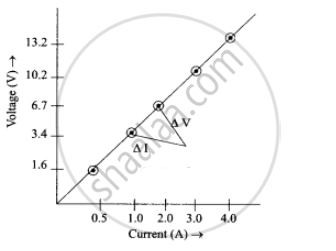Advertisements
Advertisements
Question
Exercise.
The values of current (I) flowing through a resistor for various potential differences V across the resistor are given below. What is the value of resistor?
| I (ampere) | 0.5 | 1.0 | 2.0 | 3.0 | 4.0 |
| V (volt) | 1.6 | 3.4 | 6.7 | 10.2 | 13.2 |
Solution

Resistance(R) = \[\frac{\text{∆V}}{\text{∆I}}\]
= 10.2 – `"6.7"/"3"` – 2 = 3.5/1
R = 3.5Ω
APPEARS IN
RELATED QUESTIONS
Two copper wires are of the same length, but one is thicker than the other. Which wire will have more resistance?
What happens to the resistance, as the conductor is made thicker?
An electric bulb is rated ‘240 V, 100 W’.
- What information can you get from the above statement?
- What will happen if this bulb is connected across 220 V?
- Calculate the resistance of the bulb.
- Also find the energy consumed by the bulb in 10 minutes.
The resistance of a conductor is R. If Its length is doubled, then its new resistance will be ______.
______ is the only non-metal that is a good conductor of electricity.
Three resistors are connected in series with a cell. If the current in each resistor is 1.5A, then the current through the cell will be ______.
The ______ is the measure of opposition offered by the component to the flow of electric current through it.
The process of conduction of electric current through the solution is called ______.
A rheostat is also known as fixed resistance.
Define the following:
Variable resistor
